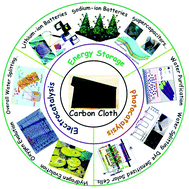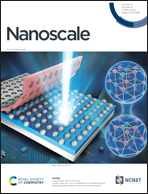Flexible 3D carbon cloth as a high-performing electrode for energy storage and conversion
Abstract
High-performance energy storage and conversion devices with high energy density, power density and long-term cycling life are of great importance in current consumer electronics, portable electronics and electric vehicles. Carbon materials have been widely investigated and utilized in various energy storage and conversion devices due to their excellent conductivity, mechanical and chemical stability, and low cost. Abundant excellent reviews have summarized the most recent progress and future outlooks for most of the current prime carbon materials used in energy storage and conversion devices, such as carbon nanotubes, fullerene, graphene, porous carbon and carbon fibers. However, the significance of three-dimensional (3D) commercial carbon cloth (CC), one of the key carbon materials with outstanding mechanical stability, high conductivity and flexibility, in the energy storage and conversion field, especially in wearable electronics and flexible devices, has not been systematically summarized yet. In this review article, we present a careful investigation of flexible CC in the energy storage and conversion field. We first give a general introduction to the common properties of CC and the roles it has played in energy storage and conversion systems. Then, we meticulously investigate the crucial role of CC in typical electrochemical energy storage systems, including lithium-ion batteries, sodium-ion batteries, lithium–sulfur batteries and supercapacitors. Following a description of the wide application potential of CC in electrocatalytic hydrogen evolution, oxygen evolution/reduction, full-water splitting, etc., we will give a brief introduction to the application of CC in the areas of photocatalytically and photoelectrochemically induced solar energy conversion and storage. The review will end with a brief summary of the typical superiorities that CC has in current energy conversion and storage systems, as well as providing some perspectives and outlooks on its future applications in the field. Our main interest will be focused on CC-based flexible devices due to the inherent superiority of CC and the increasing demand for flexible and wearable electronics.

- This article is part of the themed collection: Recent Review Articles


 Please wait while we load your content...
Please wait while we load your content...